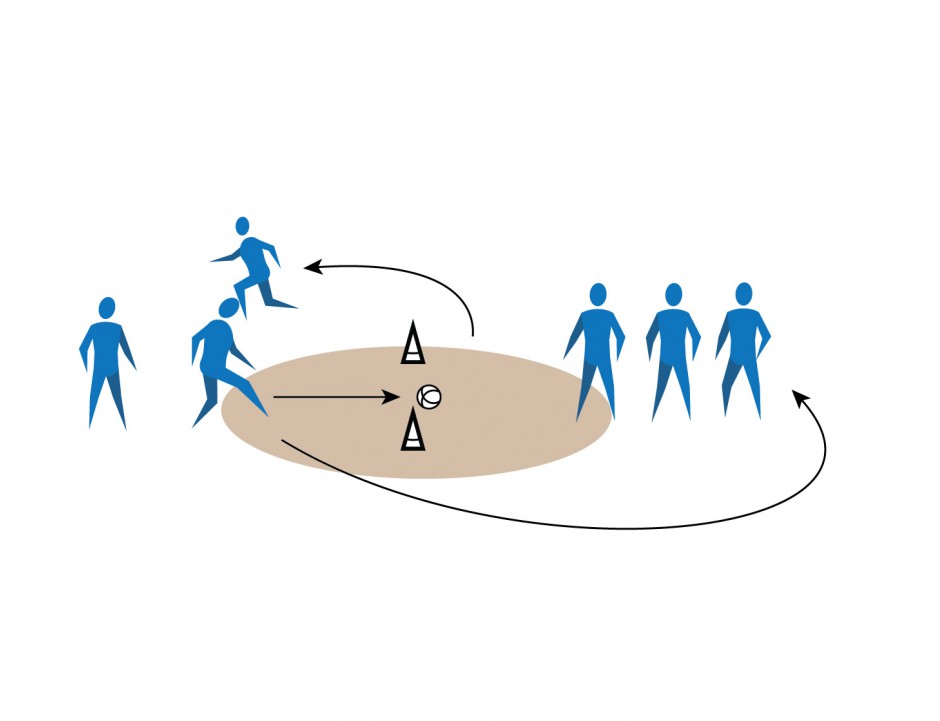TGfU Category: Target Games
Locations: gymnasium, outdoor space (e.g., field, tarmac)
Game/Sport Connections
Target games are activities in which players send an object toward a target while avoiding any obstacles. By playing these games, participants develop skills and tactics to play other target games or games that require the application of similar skills, concepts, and strategies (e.g., archery, bocce, bowling, croquet, curling, golf, horseshoes, shuffleboard, Snow Snake).
Activity Overview
Participants learn about and practise sending an object through a target.
Key Movement Skills, Concepts, and Strategies
Throughout the activity, consider highlighting the following skills, concepts, and strategies for effectively sending an object through a target. Note that this list is not exhaustive and further learning opportunities may arise during the task.
Movement Skills and Concepts
- Manipulation skills and effort awareness: using a controlled force to send the object toward the target (e.g., following through in the direction of the target to improve aim and accuracy).
- Body awareness: self-awareness of how parts of the body are moving and of body actions when sending the object toward the target (e.g., non-kicking foot stepping to the side of the ball as the kicking foot moves forward to strike the ball).
Movement Strategies
Applying appropriate skills to send the object toward the target (e.g., applying different amounts of force depending on size of the target and distance from the target, focusing on body alignment and follow through to improve accuracy).
Considerations
- Incorporate some or all of the variations listed in the “Variations” section while planning the activity. This will help to best meet the diverse backgrounds, identities, needs, and interests of participants and maximize the fun, inclusion, participation, and success of everyone.
- To elevate participant voice and choice, periodically pause the activity and share the variations with participants. Ask them to determine how they would like to change the activity to maximize the fun, inclusion, meaningful participation, and success for everyone. Encourage participants to add any variations of their own.
Equipment
- 1 object to send per group (e.g., soccer ball, beanbag, tennis ball, wiffle ball, beach ball, foam ball, plastic hockey puck, disc)
- 2 objects per group to mark sending lines (e.g., skipping ropes, rubber/vinyl spots, dome cones)
- 2 pylons per group
Safety
- Inspect the equipment and activity area to identify and remove hazards. Check that the activity surface provides sufficient traction.
- Establish the boundaries for the designated playing area at a safe distance from walls and obstacles. Share the boundaries with participants.
- Review the safety rules and activity instructions with participants prior to the activity.
- Instruct participants to be aware of their surroundings, including the locations of other participants during play.
How to Play
- Divide participants into small groups (e.g., 4 – 6).
- Groups set up their designated playing area, placing 2 pylons about 1.5 m apart to create their goal. Participants may increase or decrease the size of their goal at any point during play, being mindful of other groups’ playing areas.
- Groups mark 2 sending lines, 1 on either side of the goal. Groups choose the distance from each sending line to the goal. Groups may increase or decrease the distance between the sending line and the goal at any point during play, being mindful of other participants’ designated playing areas.
- Group members split in half with half of the group positioned behind 1 sending line and the other half of the group positioned behind the other sending line facing each other.
- Groups select 1 object to send (e.g., soccer ball, beanbag, tennis ball, wiffle ball, beach ball, foam ball, plastic hockey puck, disc) and decide how they will send it (e.g., roll, slide, bounce, strike, kick while the object maintains contact with the ground).
- Ask a participant from one of the two lines to volunteer to be the first to send the object through the goal, toward the first person in the other line of participants.
- After sending the object, the participant moves to the back of the other line of participants. The receiving participant controls the object with their hand/foot depending on how the group has chosen to send their object. The participant then sends the object back through the goal and to the next person in the other line.
- Groups keep track of the number of times the object goes through the goal.
- After all participants have sent their object through the goal and switched sides, the group repeats the task.
- After a period of play, provide participants with some or all of the variations. Ask them to decide how they might change the game to enhance their fun, challenge, and success. Encourage participants to add any variations of their own.
- Consider having groups share their variations and select another variation to try with their group.
Image: Visual Depiction of the Activity Instructions

Pause for Learning
Throughout the activity, ask open-ended questions to help participants refine their movement skills, strategies, and tactical solutions. Examples include:
- How do you position your body to successfully send the object through the goal?
- How do you change your body movements when sending various objects in various ways?
- What do you have to do to control the object when you are receiving it from another group member?
- What strategies do you use when it becomes more challenging to send the object through the goal?
- Which games or sports have you played or know about that use similar rules and strategies to the ones used in this game?
Variations
- Participants pass the object back immediately without stopping it first.
- Send the object in different ways (e.g., using the non-dominant foot, using an implement for striking).


